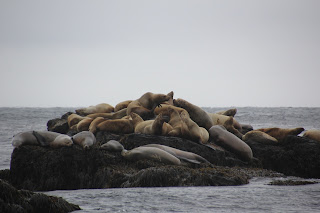It was 10pm when we saw the first glimmer of a ships mast light blinking through the foggy haze on the horizon...
Completing our final, well rehearsed yet conscious systematic preparations, packing away our thermal jackets, zipping up our Kokatat Expedition drysuits and donning headlamps, buoyancy aids and Snapdragon spray decks. Position the SKUK Explorer sea kayaks just above the surf zone on the boulder beach as the light grew dimmer, observing the timing of the sets steadily pounding the beach.
Rest the Lendal paddles in the cockpit, check the Suunto deck compass is fixed securely with the spare split paddles just in front. The barometer, fastened to my buoyancy aid just above and to the right of the front zip pocket, had been stable at 1017 for the last three hours.
Keeping as clear a deck as possible at all times. Finally clip and adjust our towlines, (previously checking and re-stowed), run through our approach and action plan (again), re-affirming the final sequence... I glance at the pattern of stickers, symbols of our sponsors and support, the vibrant orange and white logo of 'Hopes and Dream's...
At 10:40pm (Alaska time) on Tuesday 29th May 2012 with the anticipated lull in the large swell sets coming in nicely, we both pushed our kayaks into the Bering sea, wading swiftly through the foamy shallows, slippery and uneven underfoot, sat in the cockpit feet either side and delivered the vigorous strokes to take us beyond the beach breakers. George was about a second and half ahead of me and avoided the breaker I took over my open deck.
Outside the immediate danger zone, legs now inside, full contact restored feeling the anticipation and excitement which had been building through the day coursing through my body. We rafted up and I pumped out, a little chilly and we headed for the white light now about a mile away. Side by side in the darkness, natural strong easy paddle strokes, every contact point below deck felt alive and each change of pressure from my feet through my thighs to my buttocks accentuated as the kayaks moved gracefully in the increasing swell.
Darkness had descended fully as we drew along the Port side of the Puk uk, smiling welcoming friends to meet us and help us on-board, a good balance to counter the tall dark lines of the ship, rising falling above us, the ladder touching the sea then rolling high out of reach.
The sequence for boarding worked almost exactly to plan, and soon we were shaking hands, hugging Billy, Colette and Jake, and lashing the kayaks to the dinghy.
(photo by Jake Schmutzler)
And then we were continuing our journey, a new aspect to the trip, another stage in the ongoing adventure, the team a mixture of emotions, but very much a strong team, with added perspectives and experiences to discuss, reflect upon and share with others...


















